Sinterklaas
_(2).jpg)
Sinterklaas (Dutch pronunciation: [sɪntər'klaːs]) or Sint-Nicolaas (Dutch pronunciation: [sɪnt 'nikolaːs]) is a mythical figure with legendary, historical and folkloric origins based on Saint Nicholas. Other names for the figure include De Sint ("The Saint"), De Goede Sint ("The Good Saint"), and De Goedheiligman ("The Good Holy Man") in Dutch; Saint-Nicolas in French; Sinteklaas in Frisian; and Kleeschen and Zinniklos in Luxembourgish.
Sinterklaas is celebrated annually with the giving of gifts on 5 December, the night before Saint Nicholas Day in the Northern Netherlands and on the morning of 6 December, Saint Nicholas Day itself, in the (Roman Catholic) southern provinces, Belgium, Luxembourg and Northern France (French Flanders, Lorraine and Artois). He is also well known in territories of the former Dutch Empire, including Aruba, Bonaire, Curaçao, and Suriname.
He is the primary source of the popular Christmas icon of Santa Claus.[1]
Other holiday figures based on Saint Nicholas are celebrated in some parts of Germany and Austria (Sankt Nikolaus); Hungary (Mikulás); Switzerland (Samichlaus); Italy (San Nicola in Bari, South Tyrol, Alpine municipalities, and many others); parts of Bosnia and Herzegovina, Croatia and Serbia (Sveti Nikola); Slovenia (Sveti Nikolaj or Sveti Miklavž); Greece (Hagios Nikolaos); Romania (Moș Nicolae); Albania ("Shën Kolli" (Nikolli), among others. See further: Saint Nicholas Day.
Figures
Sinterklaas

Sinterklaas is an elderly, stately and serious man with white hair and a long, full beard. He wears a long red cape or chasuble over a traditional white bishop's alb and sometimes red stola, dons a red mitre and ruby ring, and holds a gold-coloured crosier, a long ceremonial shepherd's staff with a fancy curled top. He traditionally rides a white horse. In the Netherlands, the horse is called Amerigo, and in Belgium, it is named Slecht Weer Vandaag, meaning "Bad Weather Today".[2] Sinterklaas carries a big, red book, called The Book of Sinterklaas, in which is written whether each child has been good or naughty in the past year.[3]
Zwarte Piet
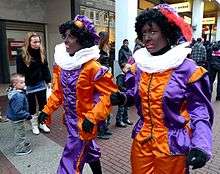
Zwarte Piet (plural Zwarte Pieten) is a companion of Sinterklaas, dressed up based on 16th-century clothes of nobles in colourful attire, often sporting a lace collar and a feathered cap. He first appeared in print as the nameless servant of Saint Nicholas in Sint-Nikolaas en zijn knecht ("St. Nicholas and His Servant/Apprentice"), published in 1850 by Amsterdam schoolteacher Jan Schenkman; however, the tradition appears to date back at least as far as the early 19th Century. The black is among other things for the black-white difference (the origin was in Roman times or even earlier, celebrating the long night and short day). But also for people playing Zwarte Piet to stay unrecognisable to the children. Children are told that Zwarte Piet is black due to the soot in the chimneys .
According to Hélène Adeline Guerber and others, the origin of Sinterklaas and his helpers has been linked by some to the Wild Hunt of Wodan. Riding the white horse Sleipnir he flew through the air as the leader of the Wild Hunt. He was always accompanied by two black ravens, Huginn and Muninn.[4] Those helpers would listen, just like Zwarte Piet, at the chimney – which was just a hole in the roof at that time – to tell Wodan about the good and bad behaviour of the mortals.[5][6] Due to its speculative character, however, this older "Germanic" theory has little support among present-day scholars, although it continues to be popular in non-scholarly sources. At the same time, it seems clear that the Saint Nicholas tradition contains a number of elements that are not ecclesiastical in origin.[7]
Sinterklaas and Zwarte Piet are typically depicted carrying a bag which contains candy for nice children and a birch rod, a chimney sweep's broom made of willow branches, used to spank naughty children. Some of the older Sinterklaas songs make mention of naughty children being put in the bag and being taken back to Spain. This part of the legend refers to the times that the Moors raided the European coasts, and as far as Iceland, to abduct the local people into slavery. This quality can be found in other companions of Saint Nicholas such as Krampus and Père Fouettard.[8] The Zwarte Pieten toss candy around, a tradition supposedly originating in the story of Saint Nicholas saving three young girls from prostitution by tossing golden coins through their window at night to pay their dowries. In recent years the roe has been absent, to adapt to modern times.
In modern adaptations for television, Sinterklaas has developed a Zwarte Piet for every function: there is a head Piet (Hoofdpiet), a navigation Piet (Wegwijspiet) to navigate the steamboat from Spain to the Netherlands, a packing Piet (Pakjespiet) to pack all the gifts, an acrobatic Piet to climb roofs and stuff presents down the chimney, or to climb down the chimneys themselves. Over the years many stories have been added, and Zwarte Piet has developed from a rather unintelligent helper into a valuable assistant to the absent-minded saint.[9]
Traditionally Zwarte Piet's face is said to be black because he is a Moor from Spain. Today, some prefer to say that his face is blackened with soot because he has to climb through chimneys to deliver gifts for Sinterklaas. The figure of Zwarte Piet is considered by some to be racist. As such, the traditions surrounding the holiday of Sinterklaas have been the subject of numerous editorials, debates, documentaries, protests and even violent clashes at festivals.[10][11]
Nevertheless, both Zwarte Piet and the holiday remain popular in the Netherlands. In a 2013 survey, 92% of the Dutch public did not perceive Zwarte Piet as racist or associate him with slavery, and 91% were opposed to altering the character's appearance.[12] Despite Zwarte Piet's popularity, many large cities and television channels now only display Chimney Petes (Roetveegpieten/schoorsteenpieten).[13][14]
Feast
Arrival from Spain
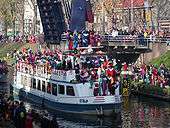
The festivities traditionally begin each year in mid-November (the first Saturday after 11 November), when Sinterklaas "arrives" by a steamboat at a designated seaside town, supposedly from Spain. The steamboat anchors, then Sinterklaas disembarks and parades through the streets on his horse, welcomed by children cheering and singing traditional Sinterklaas songs.[15] His Zwarte Piet assistants throw candy and small, round, gingerbread-like cookies, either kruidnoten or pepernoten, into the crowd. The event is broadcast live on national television in the Netherlands and Belgium.
Following this national arrival, all towns with a dock usually celebrate their own intocht van Sinterklaas (arrival of Sinterklaas). Local arrivals usually take place later on the same Saturday of the national arrival, the next Sunday (the day after he arrives in the Netherlands or Belgium), or one weekend after the national arrival. In places a boat cannot reach, Sinterklaas arrives by train, horse, horse-drawn carriage or even a fire truck.
Some suggest that mandarin oranges, traditionally gifts associated with the holy man, led to the misconception that he must have been from Spain. This theory is backed by a Dutch poem documented in 1810 in New York and provided with an English translation:[16][17]
Sinterklaas, goedheiligman! |
Saint Nicholas, good holy man! |
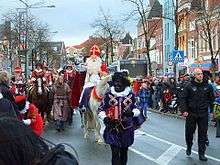
The text presented here comes from a pamphlet that John Pintard released in New York in 1810. It is the earliest source mentioning Spain in connection to Sinterklaas. Pintard wanted St. Nicholas to become patron saint of New York and hoped to establish a Sinterklaas tradition. Apparently he got help from the Dutch community in New York, that provided him with the original Dutch Sinterklaas poem. Strictly speaking, the poem does not state that Sinterklaas comes from Spain, but that he needs to go to Spain to pick up the oranges and pomegranates. So the link between Sinterklaas and Spain goes through the oranges, a much appreciated treat in the 19th century. Later the connection with the oranges got lost, and Spain became his home.
Period leading up to Saint Nicholas' Eve

In the weeks between his arrival and 5 December, Sinterklaas also visits schools, hospitals and shopping centers. He is said to ride his white-grey horse over the rooftops at night, delivering gifts through the chimney to the well-behaved children. Traditionally, naughty children risked being caught by Black Pete, who carried a jute bag and willow cane for that purpose.[18]
Before going to bed, children put their shoes next to the fireplace chimney of the coal-fired stove or fireplace (or in modern times close to the central heating radiator). They leave the shoe with a carrot or some hay in it and a bowl of water nearby "for Sinterklaas' horse", and the children sing a Sinterklaas song. The next day they find some candy or a small present in their shoes. Typical Sinterklaas treats traditionally include hot chocolate, mandarin oranges, pepernoten, speculaas (sometimes filled with almond paste), letter-shaped pastry filled with almond paste or a chocolate letter (the first letter of the child's name made out of chocolate), chocolate coins and marzipan figures. Newer treats include gingerbread biscuits or and a figurine of Sinterklaas made of chocolate and wrapped in colored aluminum foil.
Saint Nicholas' Eve and Saint Nicholas' Day
In the Netherlands, Saint Nicholas' Eve, 5 December, became the chief occasion for gift-giving during the winter holiday season. The evening is called Sinterklaasavond ("Sinterklaas evening") or Pakjesavond ("gifts evening", or literally "packages evening").
On the evening of 5 December, the main presents will somehow arrive, or a note will be "found" that explains where in house the presents were hidden by Zwarte Piet who left a burlap sack with them. Sometimes a neighbor will knock on the door (pretending to be a Zwarte Piet) and leave the sack outside for the children to retrieve; this varies per family. When the presents arrive, the living room is decked out with them, much as on Christmas Day in English-speaking countries. On 6 December, Sinterklaas departs without any ado, and all festivities are over.
In the Southern Netherlands and Belgium, most children have to wait until the morning of 6 December to receive their gifts, and Sinterklaas is seen as a festivity almost exclusively for children. The shoes are filled with carrots and sugar cubes on the evening of the fifth and often, a bottle of beer for Zwarte Piet and a cup of coffee for Sinterklaas are placed next to them. Sinterklaas largely replaces Christmas as a gift-giving occasion, usually for as long as the children are living at home. Also, when it is time for children to give up their pacifier, they place it into his or her shoe ("safekeeping by Sinterklaas") and it is replaced with chocolate the next morning.
The present is often creatively disguised by being packaged in a humorous, unusual or personalised way. This is called a surprise (from the French ).[19][20]
Poems from Sinterklaas usually accompany gifts, bearing a personal message for the receiver. It is usually a humorous poem which often teases the recipient for well-known bad habits or other character deficiencies.
When the children reach the age when they know "the big secret of Sinterklaas", some people will shift to Christmas Eve or Christmas Day for the present giving. Older children in Dutch families where the children are too old to believe in Sinterklaas anymore, also often celebrate Christmas with presents instead of pakjesavond. Instead of such gifts being brought by Sinterklaas, family members may draw names for an event comparable to Secret Santa.
History
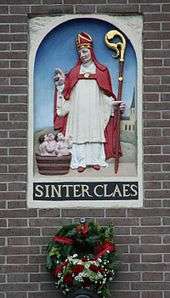
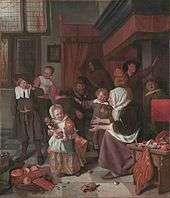

Pre-Christian Europe
Parallels have been drawn between the legend of Sinterklaas and the figure of Odin,[21] a major god among the Germanic peoples, who was worshipped in Northern and Western Europe prior to Christianization. Since some elements of the Sinterklaas celebration are unrelated to Christianity, there are theories regarding the pagan origins of various customs of the holiday stemming from areas where the Germanic peoples were Christianized and retained elements of their indigenous traditions, surviving in various forms into modern depictions of Sinterklaas. Non-Christian elements in Sinterklaas that arguably could have been of pagan origin:
- Sinterklaas rides the rooftops on his white horse which has various names; Odin rides the sky with his grey horse Sleipnir.
- Sinterklaas gives chocolate letters to children, like Odin gave the rune letters to man.
- Sinterklaas carries a staff and has mischievous helpers with black faces, who listen at chimneys to find out whether children are bad or good and report to Sinterklaas; Odin has a spear and his black ravens, Huginn and Muninn, who report what happens in the world to Odin.[22]
Middle Ages
The Sinterklaasfeest arose during the Middle Ages. The folk feast celebrates the name day, 6 December, of Saint Nicholas (270–343), patron saint of children. Saint Nicholas was a Greek bishop of Myra in present-day Turkey. In 1087, half of his relics were furtively transported to Bari, in southeastern Italy; for this reason, he is also known as Nikolaos of Bari. Bari later formed part of the Spanish Kingdom of Naples, because it was previously conquered in 1442 by Alfonso V of Aragon. The city thus became part of the Kingdom of Aragon and later of Spain, until the 18th century.
Because half the remains of St. Nicholas were in Bari (then a Spanish city), in this tradition St. Nicholas comes from Spain and has a black helper depicted as a Morisco page boy known as Zwarte Piet. Because of the help he gave to sailors in his home town, Saint Nicolas was venerated as the patron saint of sailors, which is why he comes to the Netherlands on a steamboat. His anonymous gifts and kindness towards children had already secured him the patronage of children, by the elders of Lycia, his home province. Sinterklaas' fame spread throughout Europe. The Roman Catholic Church made his name day a Church holiday. In the north of France, he became the patron saint of school children, then mostly in church schools.
In the Reformation in 16th-17th-century Europe, many Protestants and others changed the gift bringer to the Christ Child or Christkindl, and the date for giving gifts changed from 6 December to Christmas Eve.[23]
Sinterklaas is assisted by many mischievous helpers with black faces and colourful Moorish dresses. These helpers are called Zwarte Pieten (Black Pete(r)s). Although the character of Black Pete later came to acquire racial connotations, his origins were in the evil figure. Good and bad play an important role in the feast: good is rewarded, bad and evil are punished. Hence the duplication of the one Saint in a saint and a (frolicking) devil.
The feast was both an occasion to help the poor, by putting money in their shoes (which evolved into putting presents in children's shoes) and a wild feast, similar to Carnival, that often led to costumes, a "topsy-turvy" overturning of daily roles, and mass public drunkenness.
In early traditions, students elected one of their classmates as "bishop" on St. Nicholas Day, who would rule until 28 December (Innocents Day), and they sometimes acted out events from the bishop's life. As the festival moved to city streets, it became more lively.[24]
16th and 17th centuries
After the rebellion of the Dutch provinces against the Spanish Empire, Calvinist regents and ministers prohibited celebration of the Saint. The Republic of the United Provinces became an officially Protestant country following the Reformation, and its governments abolished public celebrations. The South, however, remained Catholic. People there and students in Amsterdam, which also contained a significant Catholic population, protested. The government eventually allowed private family celebration of Saint Nicholas' Day.
19th century
In the 19th century, the saint emerged from hiding and became more secularized at the same time.[24] The modern tradition of Sinterklaas as a children's feast was likely confirmed with the illustrated children's book Sint-Nicolaas en zijn knecht ('Saint Nicholas and his servant'), written in 1850 by the teacher Jan Schenkman (1806–1863). Some say he introduced the images of Sinterklaas' delivering presents by the chimney, riding over the roofs of houses on a grey horse, and arriving from Spain by steamboat, which at that time was an exciting modern invention. Perhaps building on the fact that Sint Nicholas historically is the patron saint of the sailors (many churches dedicated to him have been built near harbors), Schenkman could have been inspired by the Spanish customs and ideas about the saint when he portrayed him arriving via the water in his book. Schenkman introduced the song Zie ginds komt de stoomboot ("Look over yonder, the steamboat is arriving"), which is still popular in the Netherlands.
In Schenkman's version, the medieval figures of the mock devil, which later changed to Oriental or Moorish helpers, was portrayed for the first time as black African and called Zwarte Piet (Black Peter).[24]
World War II
During the German occupation of the Netherlands (1940–1945) many of the traditional Sinterklaas rhymes were rewritten to reflect current events.[25] The Royal Air Force (RAF) was often celebrated. In 1941, for instance, the RAF dropped boxes of candy over the occupied Netherlands. One classical poem turned contemporary was the following:
- original
- Sinterklaas, kapoentje,
- Gooi wat in mijn schoentje,
- Gooi wat in mijn laarsje,
- Dank U Sinterklaasje
- which became the contemporary version
- R.A.F. Kapoentje,
- Gooi wat in mijn schoentje,
- Bij de Moffen gooien,
- Maar in Holland strooien!
- translations
- original
- Sinterklaas, little capon,
- Throw something in my little shoe,
- Throw something in my little boot,
- Thank you Sinterklaas
- R.A.F. version
- R.A.F. Little Capon,
- throw something in my little shoe
- throw [bombs] at the Krauts
- but scatter [candy] in Holland!
This is a variation of one of the best-known traditional Sinterklaas rhymes, with "R.A.F." replacing "Sinterklaas" in the first line (the two expressions have the same metrical characteristics in the first and second, and in the third and fourth lines). The Dutch word kapoentje (little rascal) is traditional to the rhyme, but in this case it also alludes to a capon. The second line is straight from the original rhyme, but in the third and fourth line the RAF is encouraged to drop bombs on the Moffen (slur for Germans, like "krauts" in English) and candy over the Netherlands. Many of the Sinterklaas poems of this time noted the lack of food and basic necessities, and the German occupiers having taken everything of value; others expressed admiration for the Dutch Resistance.[26]
Originally Sinterklaas was only accompanied with one (or sometimes two) Zwarte Pieten, but just after the liberation of the Netherlands, Canadian soldiers organized a Sinterklaas party with many Zwarte Pieten, and ever since this has been the custom, each Piet normally having his own dedicated task.[27]
Sinterklaas in the former Dutch colonies
In Curaçao, Dutch-style Sinterklaas events are organized to this day. The Zwarte Piet characters have their faces painted all the colours of the rainbow. Prime Minister Ivar Asjes has spoken negatively of the tradition.[28] In 2011, the government of Gerrit Schotte threatened to withdraw the grant for the Dutch tradition after the Curaçaoan Quinsy Gario was arrested, when he protested in Dordrecht against the use of Zwarte Piet.[29]
Dutch-style Sinterklaas events are organized in Suriname to this day, without Zwarte Piet characters.[30] In 2011, opposition member of parliament and former president Ronald Venetiaan called for an official ban on Sinterklaas because he considers Zwarte Piet to be a racist element.[31]
In 1970 the Surinamese playwright Eugène Drenthe envisioned the character of Gudu Ppa ("Father of Riches" in Sranantongo) as a postcolonial replacement of Sinterklaas.[32] Instead of a white man, Gudu Ppa was black. His helpers symbolized Suriname's different ethnic groups, replacing Zwarte Piet. 5 December was officially renamed Kinderdag ("Children's Day") in Suriname. Although promoted by the military regime in the eighties, Gudu Ppa never really caught on.
Sinterklaas as a source for Santa Claus
Sinterklaas is the basis for the North American figure of Santa Claus. It is often claimed that during the American War of Independence, the inhabitants of New York City, a former Dutch colonial town (New Amsterdam), reinvented their Sinterklaas tradition, as Saint Nicholas was a symbol of the city's non-English past.[33] In the 1770s the New York Gazetteer noted that the feast day of "St. a Claus" was celebrated "by the descendants of the ancient Dutch families, with their usual festivities."[34] In a study of the "children's books, periodicals and journals" of New Amsterdam, the scholar Charles Jones did not find references to Saint Nicholas or Sinterklaas.[35] Not all scholars agree with Jones' findings, which he reiterated in a book in 1978.[36] Howard G. Hageman, of New Brunswick Theological Seminary, maintains that the tradition of celebrating Sinterklaas in New York existed in the early settlement of the Hudson Valley. He agrees that "there can be no question that by the time the revival of St. Nicholas came with Washington Irving, the traditional New Netherlands observance had completely disappeared."[37] However, Irving's stories prominently featured legends of the early Dutch settlers, so while the traditional practice may have died out, Irving's St. Nicholas may have been a revival of that dormant Dutch strand of folklore. In his 1812 revisions to A History of New York, Irving inserted a dream sequence featuring St. Nicholas soaring over treetops in a flying wagon – a creation others would later dress up as Santa Claus.
But was Irving the first to revive the Dutch folklore of Sinterklaas? In New York, two years earlier John Pintard published a pamphlet with illustrations of Alexander Anderson in which he calls for making Saint Nicholas the patron Saint of New York and starting a Sinterklaas tradition. He was apparently assisted by the Dutch because in his pamphlet he included an old Dutch Sinterklaas poem with an English translation. In the Dutch poem, Saint Nicholas is referred to as 'Sancta Claus'.[17] Ultimately, his initiative helped Sinterklaas to pop up as Santa Claus in the Christmas celebration, which returned – freed of episcopal dignity and ties – via England and later Germany to Europe again.
The Saint Nicholas Society of New York celebrates a feast on 6 December to this day. The town of Rhinebeck in Dutchess County, New York, which was founded by Dutch and German immigrants, has an annual Sinterklaas celebration. It includes Sinterklaas' crossing the Hudson River and then a parade to the center of town.[38]
During the Reformation in 16th-17th-century Europe, many Protestants changed the gift bringer from Sinterklaas to the Christ Child or Christkindl (corrupted in English to Kris Kringle). Similarly, the date of giving gifts changed from 5 or 6 December to Christmas Eve.[39]
Sinterklaas in fiction
In a scene in Miracle on 34th Street, a Dutch girl recognises Kris Kringle as Sinterklaas. She sits on his lap while they sing a Sinterklaas song, to the amazement of Susan Walker, who is then convinced that he's the real Santa Claus.
Sinterklaas has been the subject of a number of Dutch novels, films and television series, primarily aimed at children. Sinterklaas-themed children's films include Winky's Horse (2005) and the sequel Where Is Winky's Horse? (2007).
Sinterklaas-themed films aimed at adults include the drama Makkers Staakt uw Wild Geraas (1960), which won a Silver Bear award at the 11th Berlin International Film Festival; the romantic comedy Alles is Liefde (2007) and its Belgian remake Zot van A. (2010); and the Dick Maas-directed horror film Sint (2010).[40]
De Club van Sinterklaas is a Sinterklaas-themed soap opera aimed at children. The popular television series has run since 1999 and has had a number of spin-off series. Since 2001, a Sinterklaas "news" program aimed at children is broadcast daily on Dutch television during the holiday season, the Sinterklaasjournaal. The Dutch-Belgian Nickelodeon series Slot Marsepeinstein has aired since 2009.[41]
Much of the first half of A War of Gifts by Orson Scott Card is about the Sinterklaas tradition, including chapter 4 "Sinterklaas Eve" and 5 "Sinterklaas Day".[42]
See also
Notes
- ↑ Clark, Cindy Dell (1 November 1998). Flights of Fancy, Leaps of Faith: Children's Myths in Contemporary America. University of Chicago Press. p. 26. ISBN 9780226107783.
- ↑ Encyclopedia of Observances, Holidays and Celebrations from MobileReference. MobileReference. 1 January 2007.
- ↑ "Sinterklaas gedichten | Kies nu jouw leuke sinterklaasgedicht!". www.1001gedichten.nl. Retrieved 28 October 2016.
- ↑ Hélène Adeline Guerber (d. 1929). "huginn and muninn 'Myths of the Norsemen' from". gutenberg.org. Retrieved 26 November 2012.
- ↑ Booy, Frits (2003). "Lezing met dia's over 'op zoek naar zwarte piet' (in search of Zwarte Piet)" (in Dutch). Retrieved 29 November 2007. Almekinders, Jaap (2005). "Wodan en de oorsprong van het Sinterklaasfeest (Wodan and the origin of Saint Nicolas' festivity)" (in Dutch). Retrieved 28 November 2011. Christina, Carlijn (2006). "St. Nicolas and the tradition of celebrating his birthday". Retrieved 28 November 2011.
- ↑ "Artikel: sinterklaas and Germanic mythology" (in Dutch). historianet.nl. 3 December 2011. Retrieved 8 December 2012.
- ↑ Meertens Instituut, Piet en Sint - veelgestelde vragen, meertens.knaw.nl. Retrieved 19 November 2013; J. de Jager, Rituelen & Tradities: Sinterklaas, jefdejager.nl. Retrieved 19 November 2013. According to E. Boer-Dirks, "Nieuw licht op Zwarte Piet. Een kunsthistorisch antwoord op de vraag naar de herkomst", Volkskundig Bulletin, 19 (1993), pp. 1-35, this tradition is derived from German folkloristic research of the first decades of the 19th century (p. 2). This happened relatively early; already in 1863, the Dutch lexicographer Eelco Verwijs is found comparing the feast of St. Nicholas with Germanic pagan traditions and noting that the appearance of Wodan and Eckart in December reminds him of that of St. Nicholas and "his servant Ruprecht" (De christelijke feesten: Eene bijdrage tot de kennis der germaansche mythologie. I. Sinterklaas (The Hague, 1863), p. 40). An older reference to a possible pagan origin of a "St. Nicholas and his black servant with chains", apparently in a Dutch setting, is found in L. Ph. C. van den Bergh, Nederlandsche volksoverleveringen en godenleer (Utrecht, 1836), p. 74 ("...de verschijning van den zwarten knecht van St. Nikolaas met kettingen, die de kinders verschrikt, ... acht ik van heidenschen oorsprong").
- ↑ Christian Slaves, Muslim Masters: White Slavery in the Mediterranean, the Barbary Coast, and Italy, 1500-1800, Robert Davis, 2004
- ↑ nos.nl; Wie is die Zwarte Piet eigenlijk?, 23 October 2013
- ↑ Emma Thomas (24 October 2013). "Outrage in Netherlands over calls to abolish 'Black Pete' clowns which march in Christmas parade dressed in blackface". Daily Mail. Retrieved 27 October 2012.
- ↑ Felicity Morse. "Zwarte Piet: Opposition Grows To 'Racist Black Pete' Dutch Tradition". The Huffington Post. UK. Retrieved 27 October 2012.
- ↑ "VN wil einde Sinterklaasfeest - Binnenland | Het laatste nieuws uit Nederland leest u op Telegraaf.nl [binnenland]". De Telegraaf. 22 October 2013. Retrieved 19 December 2013.
- ↑ ; "RTL stopt met Zwarte Piet, voortaan alleen pieten met roetvegen", October 24, 2016
- ↑ ; "Geen Zwarte Piet meer in Amsterdam, alleen Schoorsteenpieten", November 4, 2016
- ↑ "Sinterklaas Arrival--Amsterdam, the Netherlands". St. Nicholas Center. 2008.
- ↑ "Knickerbocker Santa Claus". St. Nicholas Center. 4 December 1953. Retrieved 4 December 2011.
- 1 2 Archived 8 December 2008 at the Wayback Machine.
- ↑ "Sinterklaas traditions in the Netherlands".
- ↑ "Artikel: Sinterklaas Gaming Surprises" (in Dutch). Female-Gamers.nl. 15 November 2011. Retrieved 4 December 2011.
- ↑ "Examples of typical surprises" (in Dutch). knutselidee.nl.
- ↑ "Artikel: sinterklaas and germanic mythology" (in Dutch). historianet.nl. 3 December 2011. Retrieved 8 December 2012.
- ↑ McKnight, George Harley (1917). us.archive.org St. Nicholas – His Legend and His Role in the Christmas lebration.
- ↑ Forbes, Bruce David, Christmas: a candid history, University of California Press, 2007, ISBN 0-520-25104-0, pp. 68–79.
- 1 2 3 Hauptfleisch, Temple; Lev-Aladgem, Shulamith; Martin, Jacqueline; Sauter, Willmar; Schoenmakers, Henri (2007). Festivalising!: Theatrical Events, Politics and Culture. Amsterdam and New York: International Federation for Theatre Research. p. 291.
- ↑ Some of these were collected, published in 2009 by Hinke Piersma, a researcher at the Dutch Institute for War Documentation.
- ↑ Budde, Sjoukje (4 December 2008). "Hitler heeft den strijd gestart, maar aan 't eind krijgt hij de gard". De Volkskrant. Amsterdam. Retrieved 5 December 2008.
- ↑ Sijs, Nicoline van der (2009) Cookies, Coleslaw, and Stoops. Amsterdam: Amsterdam University Press. p. 254.
- ↑ "Zwarte en gekleurde Pieten op Curaçao". Nu.nl.
- ↑ "Op Curaçao hebben ze al regenboogpieten". Algemeen Dagblad.
- ↑ "Cookies op Trouw.nl".
- ↑ "Starnieuws - NDP ondersteunt Venetiaan met afschaffing Sinterklaas".
- ↑ "Leidse Courant - 19 november 1980 - pagina 15". Historische Kranten, Erfgoed Leiden en Omstreken.
- ↑ Jona Lendering (20 November 2008). "Saint Nicholas, Sinterklaas, Santa Claus". Livius.org. Retrieved 4 December 2011.
- ↑ Shorto, Russell. The Island at the Center of the World. Random House LLC, 2005.
- ↑ Jones, Charles W. "Knickerbocker Santa Claus". The New-York Historical Society Quarterly. XXXVIII (4).
- ↑ Charles W. Jones, Saint Nicholas of Myra, Bari, and Manhattan: Biography of a Legend (Chicago: University of Chicago Press, 1978)
- ↑ Hageman, Howard G. (1979). "Review of Saint Nicholas of Myra, Bari, and Manhattan: Biography of a Legend". Theology Today. 36 (3). Princeton: Princeton Theological Seminary. Retrieved 5 December 2008.
- ↑ "Sinterklaas in Rhinebeck". sinterklaasrhinebeck.com.
- ↑ Forbes, Bruce David (2007). Christmas: A Candid History. University of California Press. pp. 68–79. ISBN 0-520-25104-0.
- ↑ Guido Franken, "Sinterklaas in de Nederlandse film", Neerlands Filmdoek, 29 November 2013 (Dutch)
- ↑ "Sinterklaas", TVTropes.com
- ↑ Card, Orson Scott (November 2007). A War of Gifts: An Ender Story. Tor / Tom Doherty Associates. pp. 47–81. ISBN 978-0-7653-1282-2.
External links
| Look up sinterklaaslied in Wiktionary, the free dictionary. |
 Media related to Sinterklaas at Wikimedia Commons
Media related to Sinterklaas at Wikimedia Commons